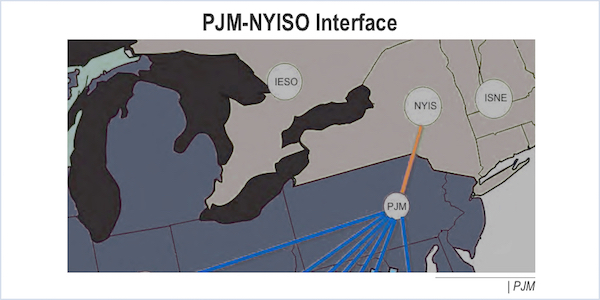By Rory D. Sweeney
VALLEY FORGE, Pa. — PJM proposed modifying an initiative on spot-in transmission by expanding it to all borders.
The proposal came despite reservations from Vitol’s Joe Wadsworth, who had won approval for a problem statement and issue charge specific to transactions between NYISO and PJM. (See PJM, NYISO Still Seeking Spot-in Tx Solution.)
PJM held a special session of the Market Implementation Committee on Wednesday, where stakeholders also debated implementing unlimited service along the NYISO-PJM seam. The seam is unique among PJM’s physical interfaces because all transactions are economically evaluated via NYISO’s clearing engine. Imports over other seams are price-takers that are paid PJM’s real-time LMP.
John Dadourian of Monitoring Analytics, PJM’s Independent Market Monitor, reiterated the IMM’s previous criticism of the unlimited service proposal, saying any market changes should apply uniformly across all borders to avoid any unintended market consequences. The Monitor is “not interested in creating a different methodology for handling [such transactions] at different borders,” he said.
Unlimited service, however, is opposed by other grid operators worried that extensive cross-border transfers could create constraints on the transmission lines of uninvolved operators. They cite language from joint operating agreements and discussions before the North American Energy Standards Board that call for limiting such transfers.
The proposal also potentially introduces new costs (and perhaps revenue) that NYISO has insisted also be shared by PJM.
As an alternative, PJM and Wadsworth have considered moving PJM’s earliest request time for spot-in service to 10 a.m. from the current 9 a.m. The delay would allow potential market participants to know if their NYISO bid has been approved before requesting service into PJM.
While Wadsworth called the alternative proposal “not great,” PJM pointed out that such service has been available in excess of 959 MW every hour since July 2015.
The Monitor asked that this proposal also be expanded to apply across all borders, which Wadsworth eventually agreed to “in the spirit of considering different solutions.”
“I don’t want to end up in a situation where we were five years ago, where we’re precluded from implementing a good solution for one seam just because it doesn’t work for all seams,” he said.
The modified problem statement and issue charge will be presented for approval at the Jan. 11 MIC meeting.




